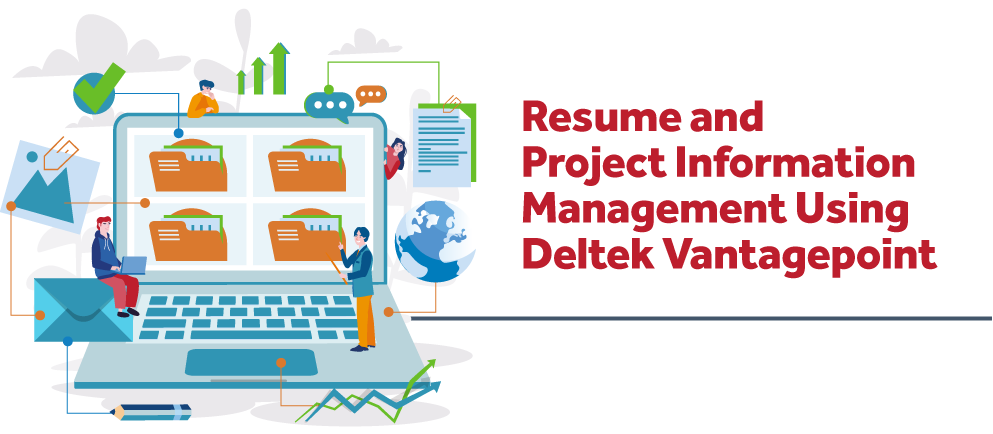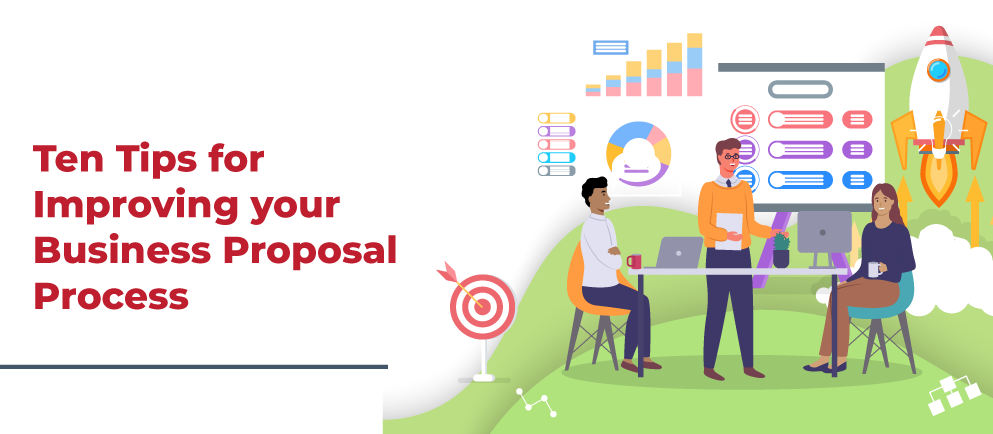Resume and Project Information Management Using Deltek Vantagepoint

In the competitive landscape of architecture/engineering (A/E) consulting, two critical assets set firms apart: their people and their projects. As a former marketing director for a large A/E firm, I fully understand the challenges involved in managing these assets effectively. Utilizing Deltek Vantagepoint, we offer streamlined solutions for managing both resumes and project information, ensuring your firm's unique strengths are showcased in every proposal, presentation, and marketing effort.
Strategic Resume Management: Capturing and Updating Professional Profiles
We perceive professional resumes not just as documents, but as dynamic profiles that showcase the strengths of your firm's most valuable assets: its people.
Starting Strong: Capturing New Hire Information
The journey of efficient resume management begins when a new employee joins your firm. This is a golden opportunity to capture their excitement and fresh perspective. Here’s how we recommend utilizing Deltek Vantagepoint and your HR processes to streamline this step:
- Coordinate with HR: At the point of hiring, collaborate with HR to integrate marketing and resume information collection into the onboarding process. Utilize HR’s existing data collection methods, adding specific forms or questions relevant to marketing needs.
- Gather Comprehensive Information: Collect essential data such as bios, previous projects, licenses, awards, special skills, software proficiency, languages, and contacts. For strategic hires, consider a dedicated marketing onboarding session to align their expertise with your firm’s marketing strategies.
- Automate with Deltek Vantagepoint: Leverage Deltek Vantagepoint to automate the information capturing process. This system can be set up to alert the marketing team of new hires, enabling the collection and updating of resume details seamlessly into your database.
Ongoing Updates: Keeping Resumes Fresh and Relevant
Regular updates are crucial to maintain the accuracy and relevance of resumes. Here's a streamlined approach:
- Determine Update Frequency: Decide how often resumes need refreshing. This can be annually, bi-annually, or aligned with each person’s work anniversary.
- Strategic Distribution: Utilize Deltek Vantagepoint to manage and schedule resume updates using email alert workflows. Provide current resumes to employees, along with clear instructions and deadlines for updates.
- Engage Personally: Consider conducting brief interviews or meetings, especially with key personnel, to ensure comprehensive and up-to-date information.
- Update the Employee Record: Once the updated information is gathered, use Deltek Vantagepoint to keep your database current. This ensures that any proposal or marketing material has the latest information at hand.
Case Study: Streamlining Annual Resume Updates at a Growing A/E Firm
A prime example of effective resume management was at my previous firm, a growing A/E firm. As the firm expanded to around 300 employees, we recognized the need for a structured yet flexible system for annual resume updates. Our strategy involved breaking down the updates into manageable monthly tasks, leveraging both Deltek and a work anniversary-based schedule. Here's an overview of our process:
Planning Phase: Leveraging Deltek Vantagepoint for Organization
- Monthly Employee Selection: Utilizing Deltek, we extracted a monthly list of employees based on their work anniversaries. This systematic approach ensured that every employee's resume was updated annually, without overwhelming our resources.
- Preparation of Update Materials: We compiled the existing master resumes from our database, along with a custom-designed resume update memo and instructions.
Gathering Phase: Personalized and Coordinated Efforts
- Distributing Update Materials: The update materials were personally delivered to employees in our main office. For our six satellite offices, we collaborated with marketing coordinators or office managers to ensure distribution. In cases where direct handover was not feasible, we used email as an effective alternative.
- Setting Deadlines and Reminders: A two-week timeframe was typically given for updates, with reminders set up in Deltek to keep track of deadlines.
- Scheduling Interviews When Necessary: For certain key roles or when detailed updates were required, we scheduled one-on-one interviews, adding a personalized touch to the process and ensuring comprehensive updates.
Updating Phase: Keeping Our Database Current
- Collection and Review of Updates: We gathered the revised resumes and additional information provided by employees, reviewing them for completeness and accuracy.
- Editing and Finalizing Resumes: Necessary edits and rewrites were undertaken to ensure that the resumes accurately reflected each employee's latest achievements and experience.
- Database Updating: Using Deltek, we updated our central database with the new information. This not only refreshed individual resumes but also ensured that our entire resume pool was current and ready for use in proposals and marketing efforts.
This case study highlights the efficacy of using a structured, technology-driven approach to manage resume updates in a large firm. By leveraging our Deltek database, we were able to streamline the process, maintain high-quality resumes, and ensure that our marketing and proposal materials always featured the most up-to-date and relevant information about our team members.
Project Information Management: Keeping Project Portfolios Up-to-Date
Just as vital as managing resumes is maintaining up-to-date project information. This includes project descriptions, milestones, and outcomes – all crucial for marketing and business development efforts. Here’s how to effectively manage this process:
- Diverse Update Methods: Consider annual updates, project milestones, pursuit-driven updates, award submittals, and initiative-driven updates. Choose the method that best aligns with your firm's needs and project types.
- Project Update Process: Establish a routine for gathering project information, such as sending out Project Information Profiles (PIPs) alerts to project teams and scheduling site visits for in-depth understanding.
- Automated Reminders and Checkpoints: Use Deltek Vantagepoint to set up workflow alerts for project updates at various milestones, ensuring no project goes unaccounted for.
Forward-Thinking Project Management: Begin with Your Goals in View
An essential aspect of managing project information effectively is to start with a clear understanding of how this information will be utilized. For instance, if a project is a potential candidate for a Design-Build Institute of America (DBIA) award, it's crucial to collect comprehensive design and construction details right from the start. Anticipating the requirements of award submissions or other future uses can guide what data to gather throughout the project's lifecycle. Utilizing past award criteria as a template for data collection ensures you capture all necessary details for future submissions.
Case Study: Site Visit Program
A practical application of this forward-thinking approach can be seen in a construction firm in Florida, which has established an effective site visit program to collect robust project information. Their marketing manager shared insights into their process, which I’ve adapted to optimize using Deltek Vantagepoint.
- Pre-Visit Preparation: Prior to site visits, a Project Information Profile (PIP) is sent to the project team via an email alert workflow. The project engineer fills in key details like project costs, square footage, and client information into the project record linked in the email.
- Collaborative Meetings: The project's key personnel, including the project manager, safety manager, and quality control manager, convene to discuss the project with the marketing representative. These meetings, often accompanied by informal gatherings over meals, foster open communication and information sharing.
- On-Site Insights: The marketing representative tours the site, gaining a visual understanding of the project. This first-hand experience is invaluable when drafting project descriptions and stories later.
- Drafting the Project Story: Back in the office, the marketing representative uses the insights gathered to draft a compelling narrative of the project, which is then refined and stored in Deltek Vantagepoint.
- Final Review and Approval: The draft is sent back to the project team for final review and approval, ensuring accuracy and completeness.
Additional highlights of their site visit program include:
- Continuous Engagement: A marketing representative is assigned to each project from start to finish, responsible for collecting initial information, attending key meetings, and ensuring all relevant documents are stored in Deltek Vantagepoint. Because Vantagepoint project records often get created in the pursuit stage, the marketing coordinator field is often populated in the project record.
- Strategic Site Visits: Site visits are conducted at critical project milestones, such as kickoff, mid-point, and completion, to gather dynamic information, including lessons learned and design insights. Workflow alerts and reminders can be sent to applicable project leads when such milestones are met.
- Leveraging Award Criteria: Award submission questionnaires are used to guide the questions asked during site visits, ensuring comprehensive data collection aligned with potential award submissions.
- Integrated Photography Sessions: Marketing representatives coordinate with photographers during project photoshoots, ensuring visual documentation aligns with the project's narrative.
This case study exemplifies the benefits of a strategic, goal-oriented approach to project information management. By integrating these practices with Deltek Vantagepoint, marketing professionals can ensure their project portfolios are detailed, up-to-date, and ready to meet any marketing or proposal need.
Integrating Resume and Project Information Management
Combining the management of resumes and project information provides a holistic approach to showcasing your firm's capabilities. Both elements are integral to crafting compelling proposals and presentations, and their management should be interlinked for maximum efficiency and impact.
- Unified Database Management: Use Deltek Vantagepoint as a central repository for both employee and project information, ensuring consistency and ease of access.
- Streamlined Processes: Establish integrated workflows in Deltek Vantagepoint for updating both resumes and project information, reducing duplication of efforts and enhancing collaboration between departments.
- Regular Reviews and Updates: Schedule periodic reviews of both resumes and project portfolios to ensure they reflect the most current and relevant information, leveraging automated reminders and scheduling tools within Deltek Vantagepoint.
Transform Your CRM Practices with Deltek Vantagepoint Workflows
Mastering the art of resume and project information management is crucial for A/E/C firms striving for excellence. Full Sail Partners' expertise, coupled with the power of Deltek Vantagepoint, provides a robust solution to streamline these processes, ensuring your firm's assets are always up-to-date and compellingly presented. Embrace these strategies to transform your information management into a strategic asset, enhancing both marketing and business development efforts.
As a next step in your journey to CRM excellence, we invite you to watch our webinar: "Automating CRM Success with Deltek Vantagepoint Workflows." You'll learn how to build and implement effective Vantagepoint workflows for CRM information collection and management, gaining insights into streamlining updates for projects in pursuit, enhancing project information management for proposals, and optimizing employee data processes. Just click the image below to watch today.




